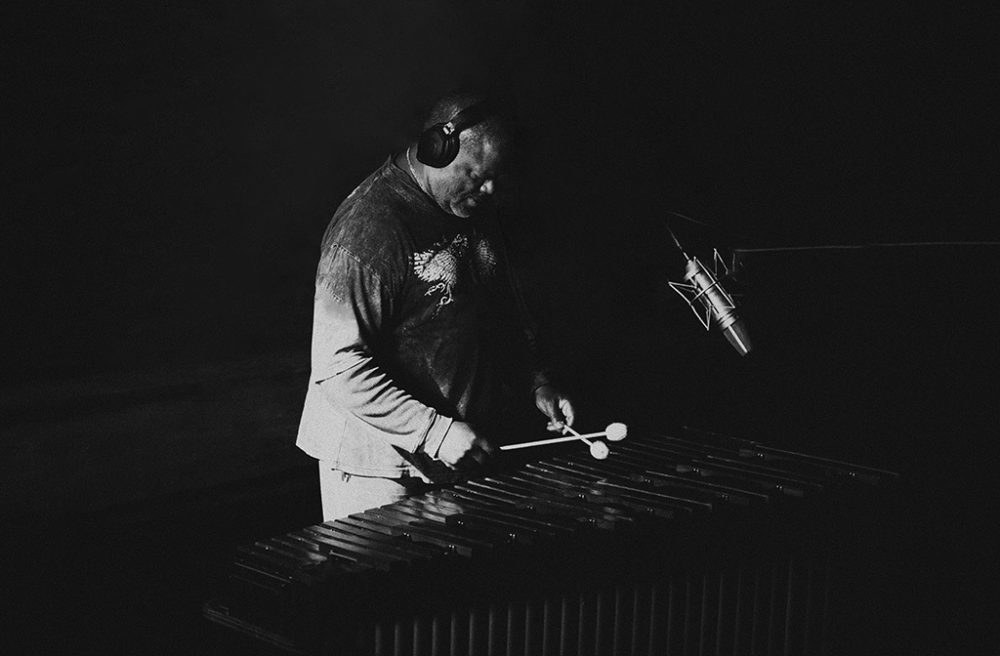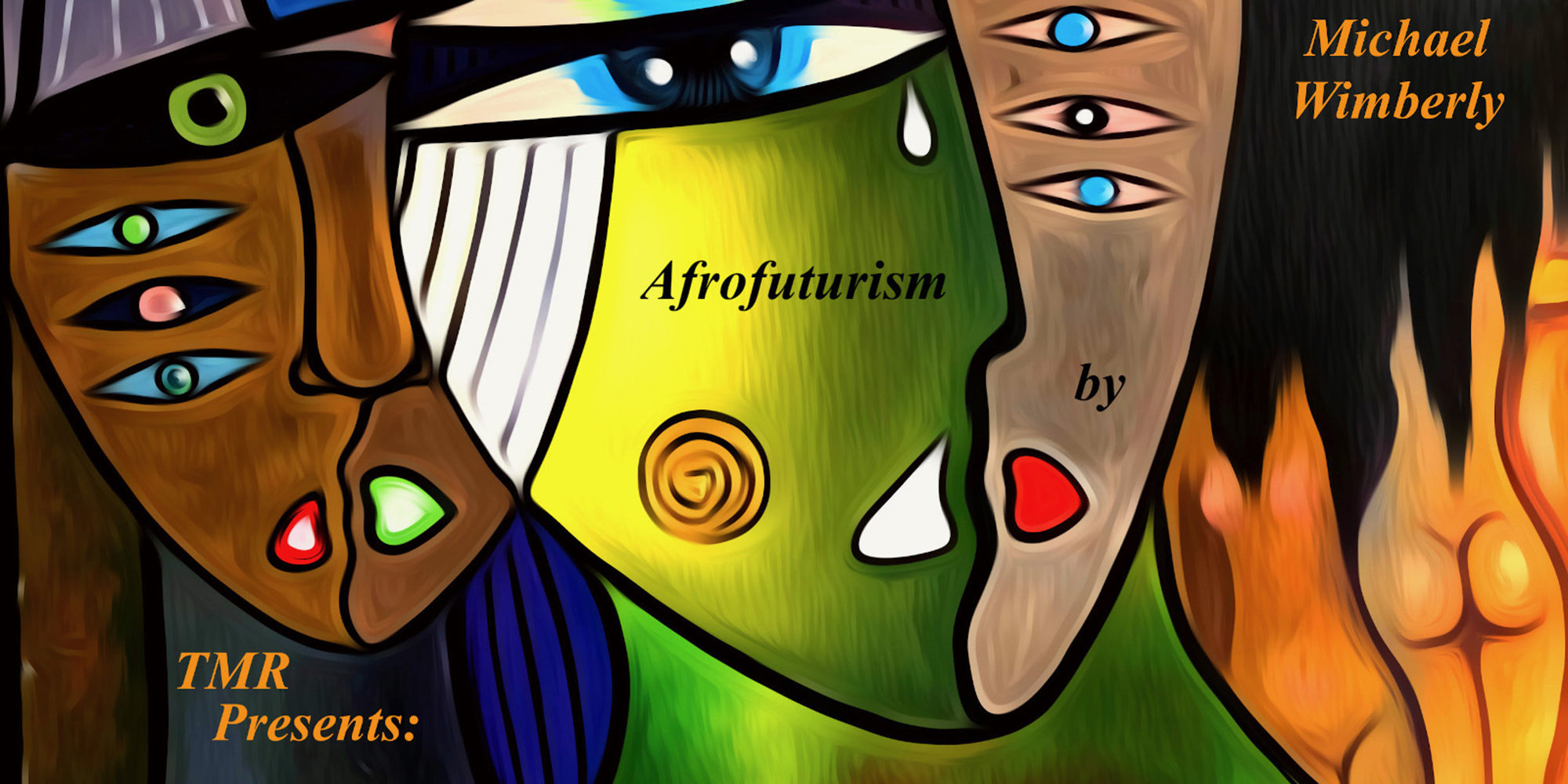Michael Wimberly is a jazz percussionist, composer, educator and more—a bona fide renaissance man. His resume is long and varied, including a stint as musical director for the Urban Bush Women dance company, an experience that led him to Mozambique in the early 2000s. For all the music he’s created and shepherded, Wimberly has only now released an album under his own name. Afrofuturism is a remarkable, wide-ranging set of songs drawing on funk, r&b, Afrobeat, neo-soul and traditional West African music. Gambian kora maestro Foday Musa Suso, Guinean balafonist Famoro Dioubate, and vocalist Misia Dioubate are among his many collaborators. Afropop’s Banning Eyre reached Wimberly to speak about the album. Wimberly began by reminding Eyre that the two had met back in 2001, when a timbila (Chopi xylophone) musician from Mozambique, Rolando Alexandre, came to New York to work with Urban Bush Women, and wound up sitting in with the group Timbila, in which Eyre plays guitar.
Banning Eyre: Yes. Rolando. I do remember him.
Michael Wimberly: That was the beginning. Plus I've been using your Afropop book for some time now.
Fantastic. So the Urban Bush Women project was the thing that brought you to Mozambique?
Yes. I went there in 2001, 2002, and then again in 2010. I was scheduled to go this past year, but of course, this happened. So, whenever life resumes, I will make an effort to get back. What's nice is that people there are using Facebook and Instagram, so I get to see who's doing what.
What were you doing there?
Well, initially, I went there because of Urban Bush Women. I was their musical director, and we were doing a play that Lincoln Center supported us on. So we just went to learn what some of the traditions were, religious traditions, language, music, costumes, art, and we kind of took all of that and weaved it into a story in collaboration with Urban Bush Women. That was very successful. It was called Shadows Child and it toured America. That was after I was done. I was purely sound designer and composer. But it struck a spark in me to go back. So then I went to study timbila.
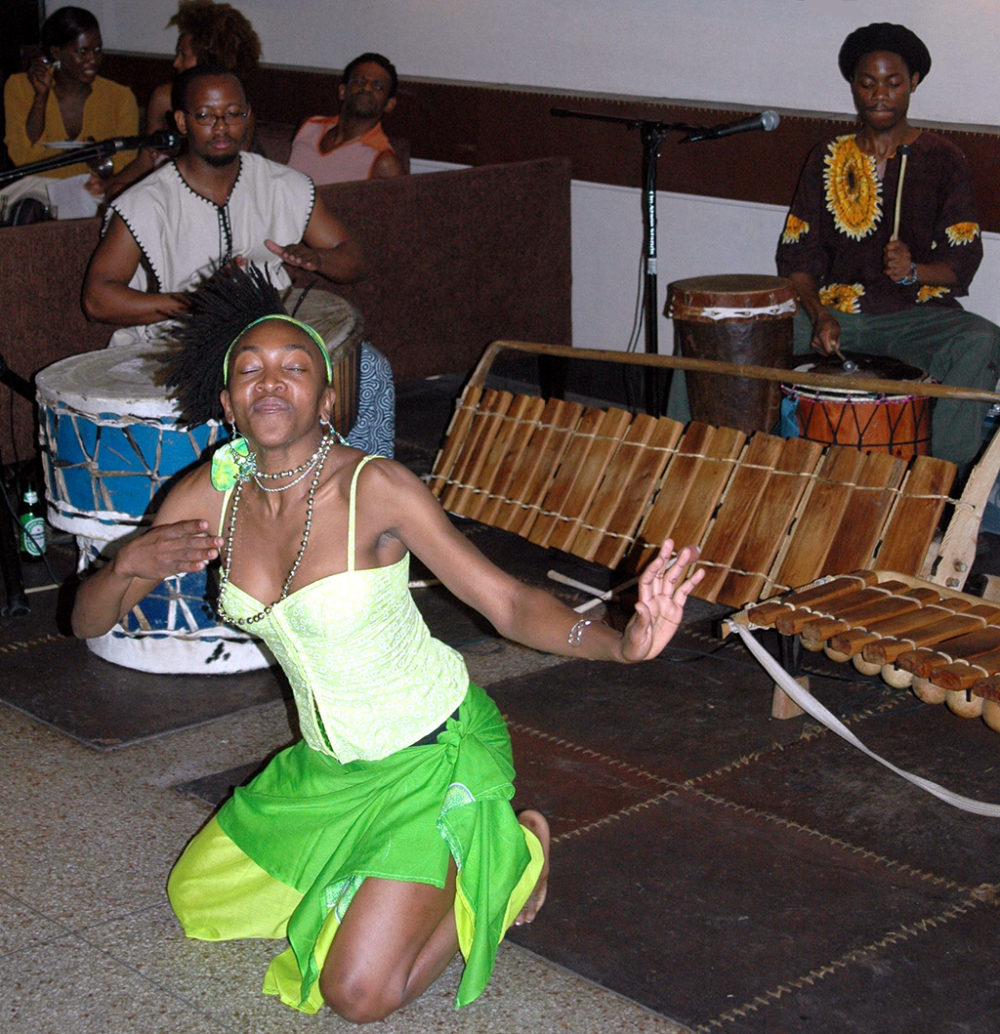
Did you already play other kinds of marimbas and xylophones before that?
I studied marimba in school, all the mallets. That was at Manhattan School of Music, and in Ohio, where I'm currently at. So that sound kind of triggered an investigation into the balafon, into the gyli in Ghana, into the timbila, just looking at some of that history and making connections to the marimba, the vibraphone.
That's rich territory.
You've been there. You know that stuff. Even in Zimbabwe, the mbira is part of that history.
Absolutely. Before we talk about Afrofuturism, tell me more about your background.
Well, I’m originally out of Cleveland, where I'm visiting family right now. How I became a drummer is… Well, do you remember the Spiegel Catalog? Maybe you're old enough.
I am, and I do.
I was just paging through it with my friends. "Hey, I want to play bass. You play drums." And that was it. Divine Providence right there. I think I always had just a musical gift that I wasn't fully aware of. Later, my mother supported me with some drum lessons, but it was really just snare drum. I didn't know this was an orchestra teacher. But that prepared me with the rudiments and reading, and I was able to play with orchestras when I was 16 or 17. I was in residence at Kent State. Unbeknownst to me, the conductor was Leopold Stokowski. I didn't have a clue. I had never been under the baton.
Well, that's a nice introduction. Was your mother a musician too?
No. She was into behind-the-scenes television, engineering. My uncle was a musician, and he did a lot of writing. He played alto sax. I heard about Charlie Parker, who used to come by and borrow the sax. That kind of thing. But he showed me radio stations. I'm talking like 1962, ’63. I would venture to say it sounded like Cecil Taylor to my 4- or 5-year-old brain. So I was very impressed with that sound, and then just the whole era of Motown and Stax, all that soul that was happening at that time. Funk. Funkadelics. That was an early experience for me. Once I started to learn djembe, I connected it all up.
I went to school with one of the Funkadelics brothers, this guy named Mike Hampton, the guitarist in the band, and that got me into the band for a really big gig in Cleveland. So that was cool. Playing djembe. And George [Clinton] featured me, which was interesting. But more importantly, it was the guitarist Eddie Hazel. He was the guitarist on that track "Maggot Brain."
I remember that track.
Eddie was just there right next to me and he told me how to play, on what side of the beat... He was a sweetheart. That was a great, great moment. And the rest of it… I went to a conservatory, Baldwin Wallace. It was a college. It’s a university now in a suburb of Cleveland. That exposed me more to contemporary music, but I was right here in Cleveland. The Cleveland Orchestra always had free concerts. Lorin Maazel. We heard all of that. My mother made sure that we got out to hear those things. We went to the Cleveland Museum of Art. I don't know how often, but it seemed we were going there quite often, because they had something for kids, drawing, things like that. So it was artistically, culturally rich enough for a kid who didn't know any more than what he was exposed to.
So with that background, how did you end up turning to Africa and African music?
I got exposed to the djembe and djembe orchestra music, the folkloric traditional songs, while I was a Baldwin Wallace undergrad, from a guy from New York. He was an organist. He came there to study Handel, Bach. A brother, studying that kind of music. But from my perspective, he was a master at playing the traditional instruments and he took a few of us in and would teach us his own Yoruba songs and chants. He was a practitioner of Yoruba religion.
Was that something he got into in New York? Or was it part of his heritage?
No, it wasn't his family. His name is Craig Brown. He is still a practitioner, and I hear he’s extremely good at it. So that's where I got turned on to djembe. And then, once I arrived in New York in 1982, the following summer, they had this thing called Dance Mobile. There was Jazz Mobile, and then there was Dance Mobile. And they would bring modern dance, ballet to the local neighborhood. I saw Chuck Davis Dance Company, which created the biggest and longest-running African dance annual event in this country, called Dance Africa.
Of course.
So when I heard those rhythms in the distance, I knew them. “I know these rhythms!” So I made that connection and I ended up joining the dance company. I worked with Chuck Davis, and ended up working with Forces of Nature, which is a contemporary African dance company. And I'm still with them. It just helps me maintain that practice.
So you are visiting Cleveland now, but you still live in New York.
Yes.
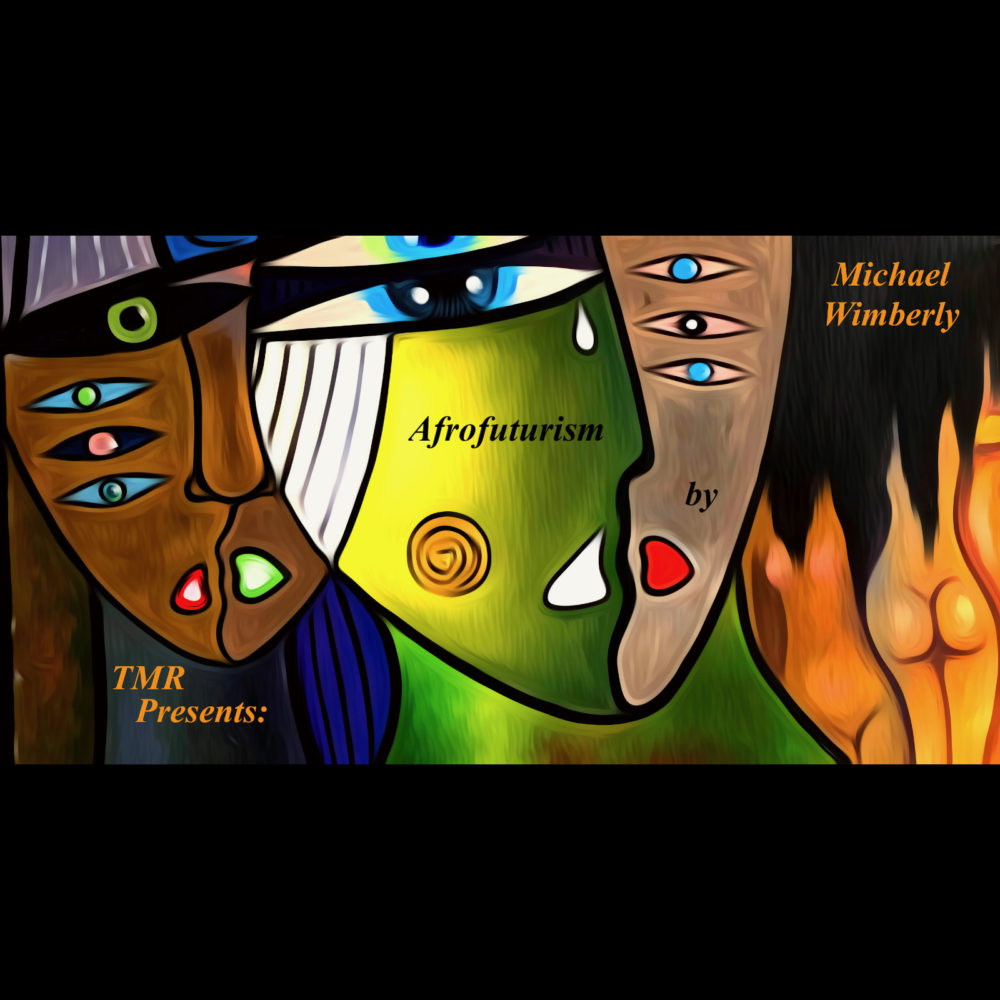
Let's talk about this record. I’ve been enjoying it. I know Famoro Dioubate and Foday Musa Suso, and they sound great in the mix. But how did all this come about? I imagine you've made other recordings.
Yes. I just haven't released them.
Oh, I know that feeling.
I am sitting on half a dozen albums that… Well, I would say this. In the early ‘90s, 1991, somewhere around there, I'm starting to compose. People were starting to engage me as a composer. I was doing stuff for Alvin Ailey. I actually worked with Alvin while he was alive, and also at the Martha Graham school while she was alive. She would come into class. I didn't know who these people were. I didn't have a clue. I learned later on. But people started hiring me to get me to write for them, and that was the age of the bedroom studio. Sequencer. Headphones. It didn’t take much.
Some of us are still in that age.
So from there, I ended up working with some interesting jazz musicians. The next thing I know, I'm getting called by Charles Gayle, a very avant-garde tenor saxophonist in the tradition of Albert Ayler and late Coltrane. Hey, man, I didn't know. I went for the ride, and it was a long ride. Many, many years. Many recordings, lots of touring. But simultaneously, I was with Steve Coleman and his Metrics group as a percussionist, not a drum set player. But to be able to work with these really strong drum set players, I kind of had my ears pulled harmonically, with this sonic cacophony from Charles, and then these other very metrically changing, harmonically changing compositions from Steve. It was a lot. I was at school.
I should say so.
And at the same time, I was maintaining the African dance stuff and recording, learning the art of recording from doing my own recordings, and then venturing out on my own. I made a little record label, but never really put that much energy into it. But I was recording people and learning that craft, and writing, and playing. When I reflect on it, I've worked with lots of people. And the travel. And what's the most common denominator when you travel and you can't speak the language? Music.
So true. So were some of those travels in Africa, other than Mozambique?
No. After all that studying of West African music tradition, I go to Mozambique first. Because I had met those folks in New York.
With the Urban Bush Women.
Right. But by that time, I had several years of European travel under my belt, so I understood the mechanics of getting out and surviving on my own, not having somebody else do it for me. The interesting thing about Mozambique was they didn't have any djembes. So when we were in New York, I took Rolando and the others to this warehouse where we found some good djembes for the price point, and they took those back. And we worked. We worked on traditional rhythms out of the west and the northwest of the continent. Their drums in Mozambique are nothing like that.
Indeed not. And now they have djembes. I think djembes are pretty much everywhere now.
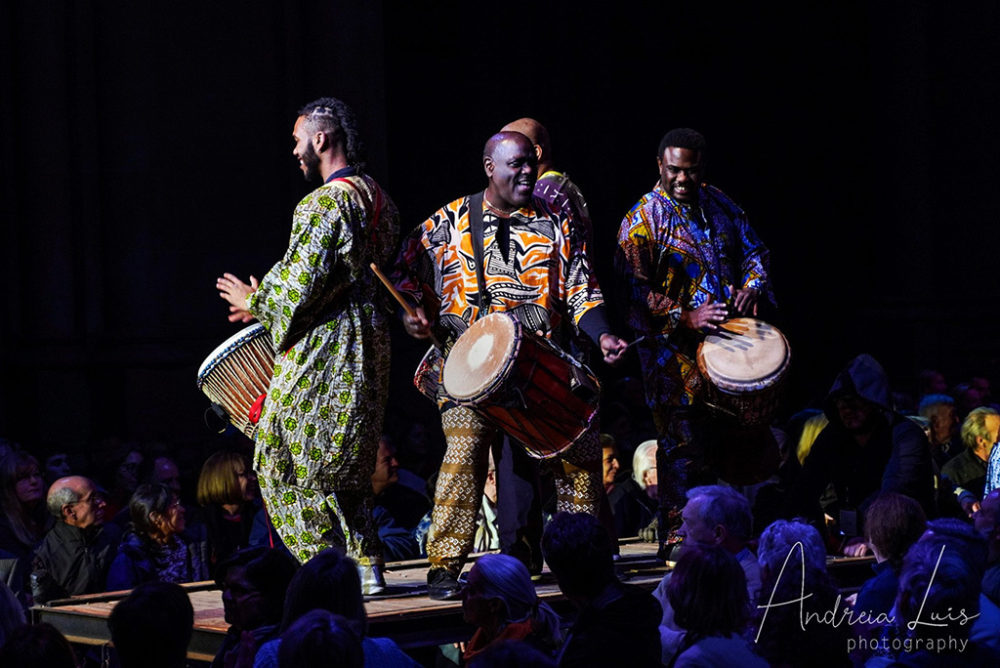
So they began to incorporate that into their sound. That was a lot of fun to see them develop that, putting those rhythms into a language and a sound that worked for them. It was crazy, man. As a matter of fact, a couple of songs on this album are inspired by a fishing song out of Mozambique. I initially built it from that. It was a women's fishing song.
Which one?
It's the song where Joss Stone is singing. We called it “Dance With You.” This one and the track that Foday is playing on are really the same tune. So I used that as the initial springboard to create that song in the studio. And then I just started to edit. And I wrote some lyrics for Joss, and she wrote some. And we kind of went back and forth on giving harmony. We had a great time. She is amazing.
I've never met her. But I've listened to her stuff. And I seem to run into her from time to time in my musical explorations. I know she did some recording in Botswana. She seems quite adventurous.
She is over in Africa, learning. Well, she was… Anyway, for this song, she learned a Mande chorus that Foday sang. I had him sing the track initially before I even brought her in a year later. But she wanted to learn it. I said, “O.K., you want to learn this chorus in Manding? Really?” And she did it. And Foday thought it was great. So it's a mix of English and that.
Was that song a beginning point for the whole album?
Yes. That song, and the song for Nelson Mandela. I actually wrote that song on timbila. It was a couple weeks before he passed. The vibe was there, and this little riff came. I played it at the Apollo with Yacouba Sissoko.
I know him well, a terrific musician.
So that was great. And then there was a third song, something we called “DDK,” very groove oriented. I just built that from some West African rhythms that I know. It's odd that I am not playing drum set on the album. I used Jonathan Joseph. But I know Jonathan and he was in town at the beginning of the project, which started in 2017. He was in town. I'm hanging out with Foday, and I thought, "Let's bring these two guys together and put them in the studio." And it was a great chemistry, and although only three things were created, the foundation was there. And I ended up taking those tracks the following year when I went to Cuba. I went with the guy who was coproducing with me, Mike Meurin, out of Canada.
We were just sitting around listening to music, posting to each other's music and playing a lot of tracks. It was a time to focus. We thought, "You know what? There's a treasure trove of material there. Let's do something with this." I knew him as an engineer from a series of percussion residencies, an international series called Kosa. We just connected and I found out that he was a good mixing engineer, and at the same time, he offered lots of really valuable suggestions that helped me streamline the production process back in the studio. And we got the Warner Music group to do a distributor deal.
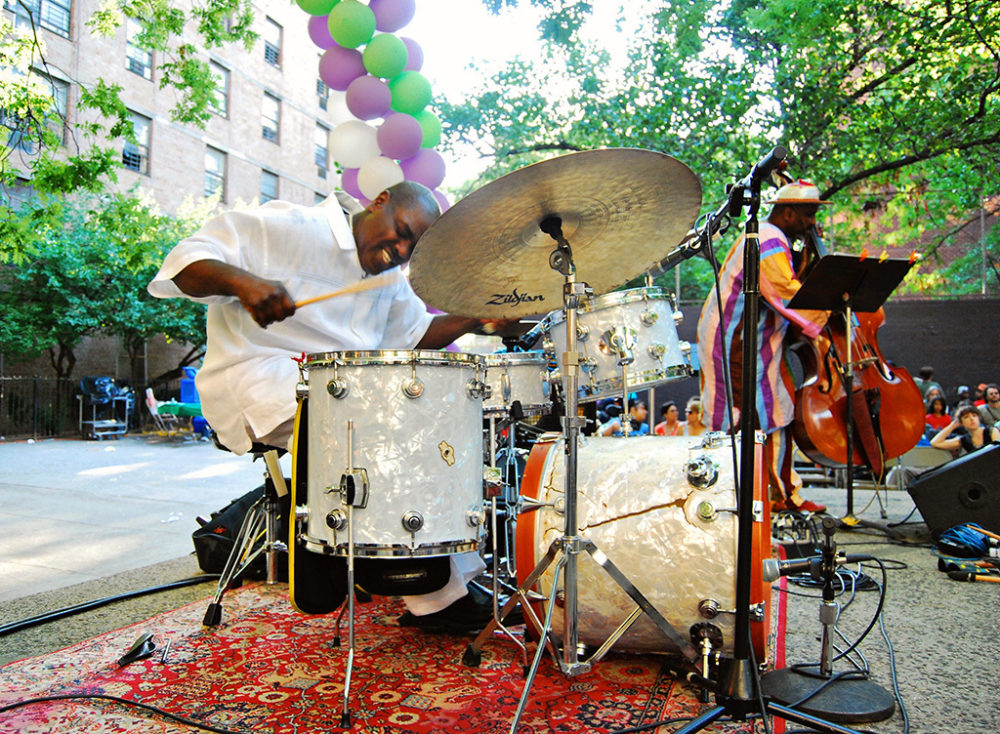
Not bad.
Right. But of course they haven't put up penny into it. It's all my money. I mean the caché is the value of the name recognition. I don't know how that's going to play out. I hope it works. But I think this is my first non-improvised project. I've done a lot of improvised album projects, and some of the other musicians out of Africa I've come across. Abdoulaye Ndiaye, a great jazz saxophonist out of Senegal. He's living in Baltimore. I've got him on a studio recording, and a couple of live sessions with an avant-garde basist, the late Norris Jones (aka "Sirone") who used to play with Sam and Dave. And he also played with Cecil Taylor a lot. So chops. And then I've worked a lot with Bakithi Kumalo, Tony Cedras…
Sure, the South African posse. But I note that there is no timbila on this record.
Right. Timbila is not on the record. You would've noticed that. I took the chance to bring in Famoro Dioubate on balfon, and the singer from Guinea, Missia Dioubate. Her brother played bass on some of the tracks. I loved his parts, but some people felt that we needed something different on some tracks. So we brought in Trevor Allen and the Cuban bass player Armando Gola. There were a lot of people involved over time. I do a lot of overdubbing. I do play vibraphone and organ on it. I had never played organ, ever. But I played keyboards, so I figured it out, and that was a lot of fun, just to kind of layer.
And then the drummer, Jonathan Joseph, who is a powerful drum set player, suggested, "You know, Mike, I think we need a little more production on this." Had I had more time and more money, I could have worked out horn arrangements. I had little fiasco with the strings. It was live strings. Somebody was slightly out of tune. I couldn't hear it, but when you hear the playback, you notice. So I couldn't use any of that. That was money.
But other than that, the project inspired me. Because I'm pulling from something I wrote in the 1990s that still has relevance. And then the Mandela piece. Everything else was kind of tailored for that moment. Also my collaboration with a guy in Australia, Gary Pinto. We wrote a song called "Radio." A little more poppy. But the original lyric told a different story. It was about a band that kind of gets lost into the abyss. After they get signed, they have to do all these things and they just really want to go back to the bar and play music the way they used to play it. But with the onset of the Trump era and all of that language, Gary wanted to revise the lyrics. So he did. We kept the chorus, but he just came up with a whole different story.
You ended up putting the whole album under the banner of Afrofuturism. Talk about what that means to you.
Originally it was The Michael Wimberly Sessions. But I started reflecting on who I am, and what I teach, and my influences. I teach a class on Sun Ra and his innovation, his concepts and perspectives, philosophy, poetry. So that influenced me. Also, simultaneously with the Funkadelics, growing up in that era, Sly and the Family Stone, Patti LaBelle, those very influential people who were at the forefront of this Afrofuturistic idea, seeing themselves in the future, through a space lens more or less.
I know that Mike Dery coined the term Afrofuturism, and it's not that I'm crazy about the term. But the idea behind it I've always adapted. I've always enjoyed the Art Ensemble of Chicago's "ancient to the future" concept. And I think that the music on the album having these really ancient rhythms that I'm pulling from and juxtaposing into the modern ’70s era. “Mack Daddy’s Woman”-- the harmonic vibe of that, bringing it forward and thinking about Mandela in that region of Africa, knowing that I'm inspired by the rhythm set of Mozambique and West Africa – all of that is there. And so I started to make this connection. "Wait a minute, I'm trying to see myself in the future as a man of color, and culturally, can this body of music reflect my culture?" And I think it does.
I sometimes teach Afrofuturism and you go into the theory of it, and the interdisciplinary concepts, some of the predecessors, and some of the current artists who are practicing it and who have been recipients of that. That's kind of where I'm coming from with it.
I'm working on a program about jazz and African music. It’s basically pegged off some interesting albums that I've been enjoying recently. For the most part these are coming out of the African pop world, but they have a strong influence of jazz with solos and improvising and strong brass arranging. It's a subject Afropop has touched on before. We've dealt with the fact that jazz isn't really all that popular in most African cities. It tends to be a music of a small elite. But it's interesting to me at the point at which it resonates. You think about Fela, and of course his music is loaded with jazz inspiration. But when you get to the point of bebop and avant-garde, most African listeners drop off and stop relating to it. I spoke with Lionel Loueke about this one time. I know he was frustrated by that limitation in Benin, and that's part of the reason he came to the U.S. He wasn't speaking the same language anymore. But I'm kind of interested in how that's evolved. I mean if you look at other kinds of Black music: funk, blues, hip-hop. African artists incorporate these things readily. But jazz has a different kind of trajectory.
Well, it's the same in America. When you look at the advent of bebop, that was breaking away from the main swing and danceability of the music. It was a taking something back, because so many white players began to play swing, and these bebop players were, "Hey, we need to create our own thing again and get away from that." But with Africa, I have played with jazz musicians from there, but it is a small percentage of people who listen to it. And I don't know why. But I do understand that culturally—and I'm talking about the continent—their traditional and folkloric music is rhythm-based. When you are looking at pentatonic melodies, and something about the body resonating with that, some of the scales structures that come from the various instruments they play – I'm thinking more traditional instruments.
I think the people maybe need to have access to it, and educate themselves on that. How do you do that? I think you have to start targeting kids, and bring it into elementary schools in order to broaden their awareness. But you are not going to be able to sell more advanced musical concepts to a people who culturally, traditionally groove. It's a groove continent. Think about it. South Africa. Groove music. Even the mbira. It's deep. I mean that thing, it's avant-garde.
But the groove is there always. Sometimes it's hard to know where the downbeat is, but you can always feel the groove.
In Mozambique, I made a film of the timbila. Timbila music is dense. It's harmonically dense. It's not easy.
But it is still groove music. It's not a groove that's easily accessible to Western listeners, but it is a groove, a very advanced and unusual stream in the river of groove.
Right. And it goes way back, some of these musical forms and melodies and the development. You can see this in the interviews I made. They're paying homage to the tradition, they feel they must respect that first before they fold that into a mainstream or modern direction. They can make it work.

I remember taking Rolando Alexandre, the timbila player, to a jazz session when those Mozambican artists were in New York. I was playing with some avant-garde improvisers, and I had Rolando come down with the timbila. And I pushed him to get up there and wail, just to bring his sound into that sonic relationship. He did it. But of course he went back to grooving. That's what he knows. That's what he loves. And I thought, "Why am I pushing him to do this thing?"
I guess just for the experience. But I hear what you're saying about the groove. I went through version of this myself. After playing a lot of kinds of music, I moved to Boston and went to Berklee for a while to learn jazz. And the reason I wanted to learn it was to be part of a shared culture. I mean, my favorite jazz was not guitar music, and my favorite guitar music was not jazz. But I wanted to have that language and repertoire in order to have a shared repertoire with other people. I enjoyed that for a while. But then when I discovered African music, I got that fix in a way that I liked a lot more from grooving Shona and Mande music. Because as with jazz, everybody knew a shared set of songs so you could play with people right away. But it wasn't about playing the song exactly. It was about putting your own personal expression into this shared space. I love that.
This is an area that still needs to be explored.
Tell me a more about your timbila film.
The working title was The Sound of Freedom. Venancio Mbande is probably one of the most prolific composers and inventors, strengthening the instrument. He changed the pitch of it, putting it in another key. There are a number of makers that I was around, and so it was interesting to see the difference of the older model and this newer model. Newer mallets. Newer construction. Fuller sound. You're still talking about beating on wood, but they changed the tuning.
Did they temper the tuning so they could play with Western instruments? Or did they keep the funky tuning?
No you can't play it with the older version, but they do keep the funky tuning. You're just going to have to adapt to it.
Yes. I have faced that challenge.
The interesting thing was to go up to an annual timbila festival in an area called Zavala.
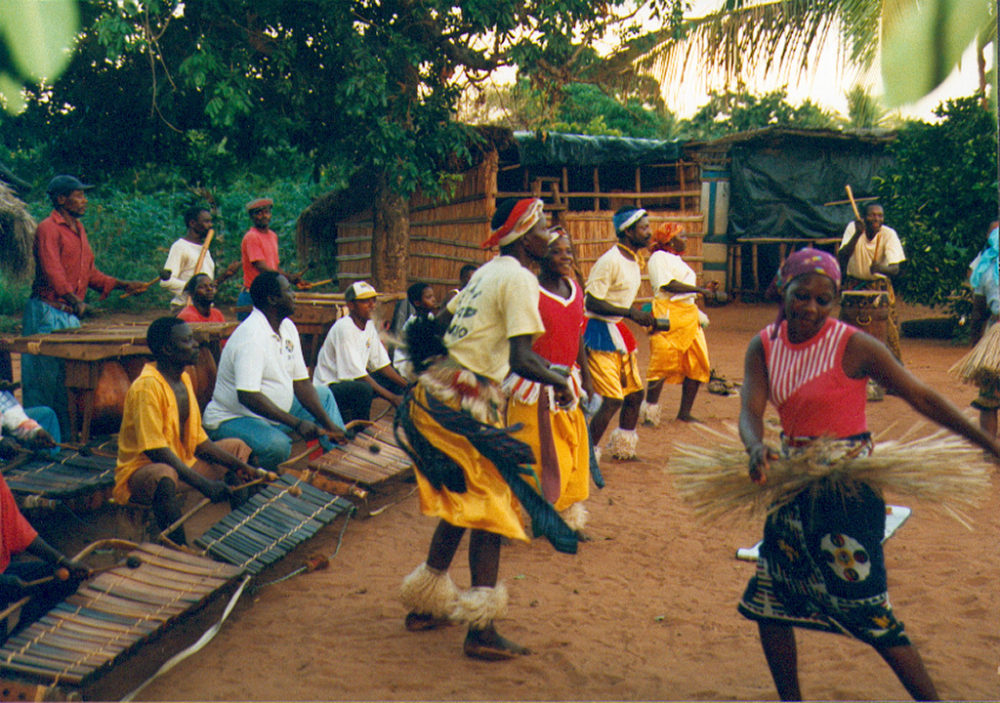
I went there once and visited Venancio Mbande. When I arrived, he wasn't there. He was off playing an all-night gig. So I waited with his wife and kids, though we shared no language. The next afternoon he and his musicians showed up after the gig, and they set up and played for me. Amazing. So did you go up there specifically to make this film?
No. Not at all. I went there because of Lincoln Center and this work with Urban Bush Women. We were trying to figure out what kind of play we were going to make. It was me and a choreographer and a costume designer. But on that trip I made arrangements to go and visit Venancio, and it just so happened that there was a South African crew of two guys who had been granted funds to travel throughout Africa and teach people how to capture their culture using cameras and Final Cut Pro. That was their gig. And they happened to be in Mozambique when I did my trip. What are the odds?
I also go to the Azores quite often. Although my Portuguese is very limited, I've met some great artists there. But I went back in 2010, and I did what they said. I hired a local film camera guy and he went me on that trip to Zavala to videotape the timbila festival and some of the traditional groups in Maputo.
Well, let us know when that film is available. I’m sure our listeners would love to see it.
Thanks, man. This was a pleasure.
